Agrius cingulata
|
|
Created as per image and data submission from Kathy Genaw (Na Pali State Park, Kauai, Hawaii) October 28, 2010; November 3, 2010
Updated as per Hawkmoths of the World, Kitching and Cadiou, 2000; November 3, 2010
Updated as per personal communication with Ian J. Kitching, Jean Haxaire and James A. Tuttle, November 3, 2010
Updated as per Tony Pittaway's website, November 3, 2010
Updated as per personal communication with Marketa Murray, December 2, 2021; December 4, 2021
|
Hippotion rosetta
hip-POE-tee-onmm roe-ZET-tuh
The Vine Hawk Moth
(Swinhoe, 1892) Choerocampa rosetta
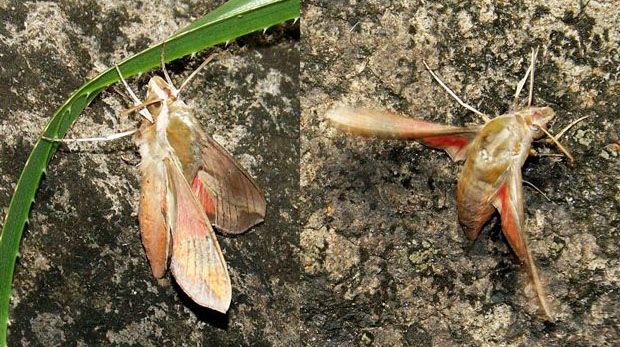
Hippotion rosetta, Na Pali State Park, Kauai, Hawaii,
courtesy of Kathy Genaw, images composited by Bill Oehlke.
This site has been created by Bill Oehlke.
Comments, suggestions and/or additional information are welcomed by Bill.
TAXONOMY:
Family: Sphingidae, Latreille, 1802
Subfamily: Macroglossinae, Harris, 1839
Tribe: Choerocampina, Grote & Robinson, 1865
Genus: Hippotion Hubner [1819]...........
Species: rosetta (Swinhoe, 1892)
|
This page is inspired by and dedicated to Kathy Genaw who sends the images credited to her on this page.
Kathy writes, "The attached photos of a very nice sphinx moth of some kind were taken at Na Pali State Park during my recent visit to Kauai.
Photographing and raising butterflies and moths is a hobby of mine, and I was delighted to find this lovely little flyer. Hope you can help me ID it
more specifically."
I did not have Hippotion rosetta listed on my Hawaiian Sphingidae page, and did not recognize the species. Jean Haxaire, Ian J. Kitching and James A. Tuttle
often help me with identifications, so I forwarded the images to them for identifications.
Jean Haxaire writes, "This seems to be Hippotion boerhaviae (Fabricius, 1775), but it also could be H. rosetta (Swinhoe, 1892).
"Only the dissection could give an absolute and definitive answer. The two sp. are really close."
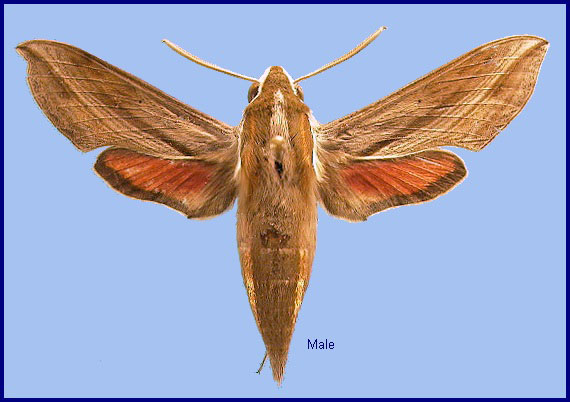
Hippotion rosetta male (possible gender error), courtesy of Tony Pittaway.
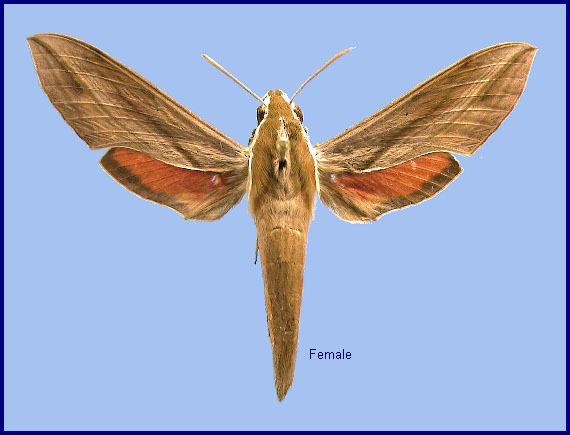
Hippotion rosetta female (possible gender error), courtesy of Tony Pittaway.
Ian J. Kitching writes, "I would say that the Hippotion is H. rosetta. The outer margin of the forewing is rather convex, the forewing postmedian
bands are not that well-developed and the hindwing red has an orange tinge (in boerhaviae it is often more pinkish). Furthermore, H. rosetta has
already been recorded in Hawaii, some of the specimens of which were identified by Jean-Marie Cadiou.
"The reference is: Kumashiro, B.R., Heu, R.A., Nishida, G.M. & Beardsley, J.W. 2001. New state records of immigrant insects in the Hawaiian Islands for the
year 1999. Proc. Hawaiian Ent.Soc. 35: 170-184.
"H. rosetta was recorded from Manoa, Honolulu airport (in a cargo container from Taiwan), Oahu (Pawaa, larvae on Boerhaavia). Furthermore, a
specimen was also recorded from Omao, Kauai on November 18 1998, then a new record for Kauai. This was followed by three more at Wailua Homesteads,
Kauai in December 1998 and January 1999."
James Tuttle forwarded the images to Dan Rubinoff who "indicates that H. boerhaviae can be fairly common in Hawaii, but he wasn't at all
confident that the image was boerhaviae."
Based on this communication, I have added both Hippotion boerhaviae and Hippotion rosetta to my checklist for Hawaii, and I have tentatively
posted Kathy's images to this page as H. rosetta.
The additional information below (in quotation marks) on this page comes from Tony Pittaway's excellent website.
In early December 2021, I received three images below from Marketa Murray. I believe they are either Hippotion rosetta or Hippotion boerhaviae.
It is difficult to distinguish between the two species even when there is a full view of the forewings. I will also post them on the boerhaviae page.
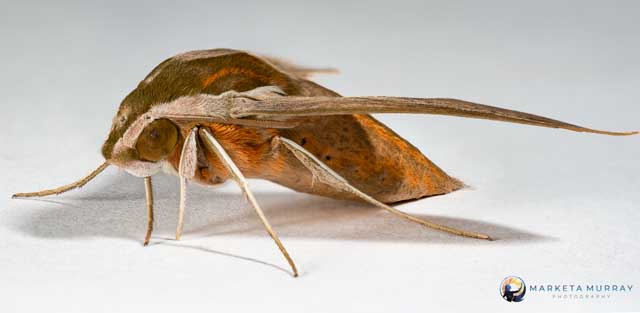
Hippotion rosetta/boerhaviae, Hawaii, December 2, 2021,
courtesy of Marketa Murray.
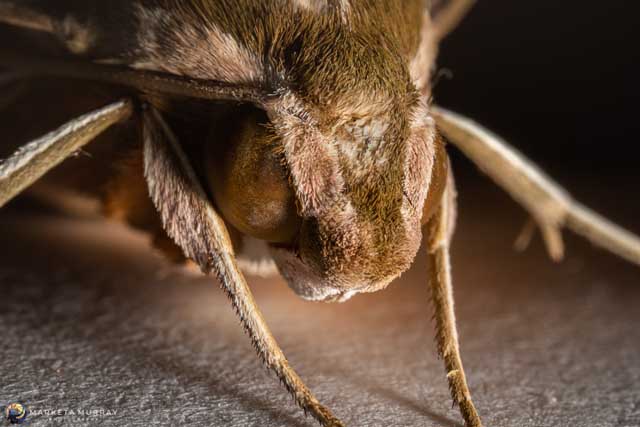
Hippotion rosetta/boerhaviae, Hawaii, December 2, 2021,
courtesy of Marketa Murray.

Hippotion rosetta/boerhaviae, Hawaii, December 2, 2021,
courtesy of Marketa Murray.
DISTRIBUTION:
The Vine Hawk Moth, Hippotion rosetta, (wingspan: mm),
flies in "type locality: [Indonesia, Maluku,] Ceram [Seram], and China: Yunnan (Kunming; Huanglian Nature Reserve, 2060m); Guangdong (Guangzhou;
Lianping; ??Wan-tzi-san); Hong Kong (Shau Kei Wan); Hainan (Chengmai); Taiwan: Nantou Hsien (Lushan spa; Huisun Forest; Puli); Tainan;
Kaohsiung Hsien (Liukuei); Taichung Hsien (Pahsien Shan), and Japan: Honshu (Taira); Ryukyu Archipelago (Iriomoteshima; Ishigakishima)."
It has a further global distribution "from southern Pakistan, India and Sri Lanka, eastwards across Thailand, southern China and Taiwan to southern
Japan (Ryukyu Archipelago) and the Philippines, and then southwards across South East Asia to the Andaman Islands, eastern Indonesia, the Solomon Islands
and the Torres Straits of New Guinea."
Apparently it occasionally makes its way to Hawaii.
Adults seem especially attracted to "the flowers of Lantana camara, Duranta erecta and Ixora in Hong Kong, flying for most of the night
(Tennent, 1992)."
FLIGHT TIMES AND LARVAL HOST PLANTS:
"China: i-xii (Hong Kong); 20-21.vi (Yunnan); vii (Hainan). Taiwan: v (Kaohsiung Hsien); vi (Taichung Hsien); vi (Nantou Hsien); vii (Nantou Hsien); viii
(Tainan). Japan: 24.iv (Ryukyu Archipelago); 22.vi (Honshu); 6.x (Ryukyu Archipelago).
"Kendrick (2002) states that it is multivoltine in Hong Kong, occurring from March until November, with peaks in late March, May and early October."
Possibly there is a December flight in Hawaii.
"Larval hostplants. Borreria, Morinda citrifolia and M. umbellata (Rubiaceae). In Hong Kong it has also been found on
Pentas lanceolata (David L. Mohn, pers. comm. 2005)."
ECLOSION:
Pupae probably wiggle to surface from
subterranean chambers just prior to eclosion.
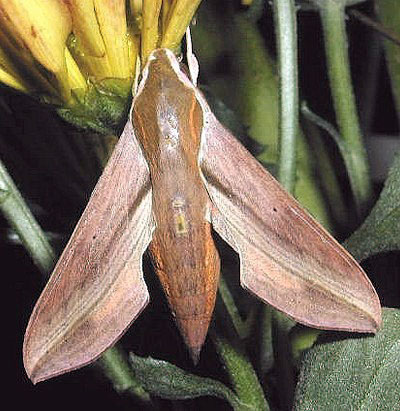
Hippotion rosetta resting, courtesy of Tony Pittaway.
Larvae apparently can occur in at least two forms: green and dark brown:
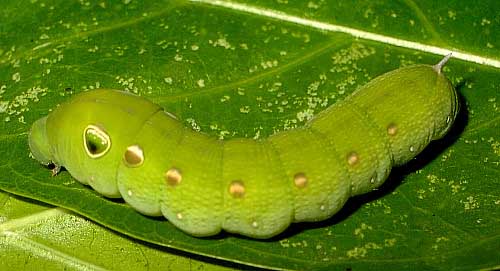
Hippotion rosetta larva (green form, possibly earlier instar), courtesy of Tony Pittaway.
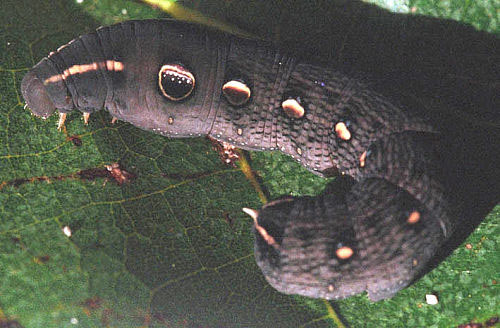
Hippotion rosetta larva (dark form), courtesy of Tony Pittaway.
Use your browser "Back" button to return to the previous page.
This site has been created by Bill Oehlke.
Comments, suggestions and/or additional information are welcomed by Bill.
Enjoy one of nature's wonderments: Live
Saturniidae (Giant Silkmoth) cocoons.
 | 
Show appreciation for this site by clicking on flashing butterfly to the left.
The link will take you to a page with links to many insect sites. |










